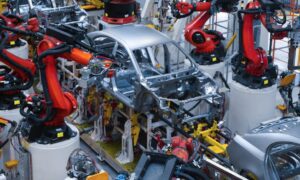Welcome to the age of innovation, where technological advancements are transforming every aspect of our lives. From smartphones to self-driving cars, we live in a world that seems straight out of a science fiction novel. But as we marvel at these cutting-edge creations, it is crucial to pause and reflect on the ethical implications they bring along. As robotics takes center stage in this era of progress, we must strike a delicate balance between pushing boundaries and ensuring responsible development. In this article, we will explore how we can navigate the uncharted waters of robotic advancement while upholding our values and ethics.
Introduction to Robotics
Robotics technology has revolutionized manufacturing, design, and communication across factories. However, as the industrial and service robotics markets have begun to rapidly grow in both size and sophistication, so too have ethical concerns about their impact on society.
As responsible roboticists look to ensure that advances in robotics technology benefit humanity as a whole, they must consider the potential ethical implications of their work. This includes taking into account the potential for robots to cause harm or displace workers, as well as ensuring that any benefits of robotics technology are distributed fairly.
In order to help guide roboticists as they navigate these challenges, a number of ethical frameworks have been developed. These provide valuable guidance on how to assess and mitigate the risks associated with developing and deploying autonomous systems.
When it comes to promoting responsible innovation in robotics, it is crucial that all stakeholders from government and industry to academia and civil society work together. Only by doing so can we ensure that the benefits of this transformative technology are realized while minimizing its risks.
The Legal and Ethical Considerations of Robotics
As robotics technology continues to develop and advance, it is important to consider the legal and ethical implications of these changes. Robotics has the potential to revolutionize many industries, but it is also important to ensure that these advances are made responsibly.
There are a number of legal and ethical considerations that need to be taken into account when developing robotics technology. For example, who will be held responsible if a robotic device causes harm? How should we ensure that robots are used ethically and in line with our values?
It is important to consider these issues carefully in order to ensure that robotics technology is developed responsibly. We need to strike a balance between innovation and ethics to create a future that is safe and beneficial for all.
Social Impact of Robotics
The social impact of robotics is far-reaching and complex. As robots become increasingly advanced and ubiquitous, they will have a profound impact on the way we live and work. They will affect our economy, our politics, our culture, and even our sense of what it means to be human.
In many ways, robots are already having a positive impact on society. They are helping us automate repetitive and dangerous tasks, freeing up humans for more interesting and creative work. They are also providing new opportunities for people with physical disabilities or impairments.
However, there are also potential negative social impacts of robotics that we need to be aware of and address. For example, as robots become more capable, they could replace humans in many jobs, leading to large-scale unemployment. Alternatively, if robots are not well regulated, they could be used for unethical purposes such as surveillance or warfare.
It is important that we consider both the potential positives and negatives of robotics as we continue to develop this technology. We need to ensure that we are creating responsible robotic advancement that benefits society as a whole.
Advantages and Disadvantages of Robotics
There are many advantages and disadvantages of robotics. Some of the advantages include:
- Robotics can help automate tasks and processes.
- They improve efficiency and productivity.
- Helps reduce costs.
- improves safety.
- Helps customize products and services.
- Robotics can create new jobs and industries.
Some of the disadvantages of robotics include:
- Robotics technology is still emerging and evolving, which can make it expensive and unreliable.
- Robots can malfunction or break down, which can cause injury or death.
- If not properly designed or programmed, robots can be biased or discriminatory.
- Robots could eventually lead to mass unemployment as they increasingly automate jobs that humans currently do.
Responsible Innovation through the Use of Regulatory Bodies
There is no question that robotics and artificial intelligence are revolutionizing the way we live and work. But as these technologies become more ubiquitous, it’s important to ensure that they are developed responsibly. One way to do this is through the use of regulatory bodies.
Regulatory bodies can help ensure that innovation is responsible by setting standards and guidelines for developers to follow. They can also provide a forum for discussion and debate about the ethical implications of new technologies.
In order for regulatory bodies to be effective, they need the support of government, industry, and academia. Government can provide funding and legal authority, while industry brings expertise and commercial interests. Academia can offer critical analysis and help identify potential risks.
The key is to find the right balance between regulation and innovation. Too much regulation can stifle innovation, while too little can allow unethical practices to flourish. But the right approach can enable regulatory bodies to ensure the responsible development of robotics and AI, benefiting everyone.
Examples Of Responsible Robotic Advancement
As the world becomes increasingly digitized, robots are playing an increasingly important role in our lives. From manufacturing and logistics to healthcare and customer service, robots are becoming a staple in many industries. While recognizing the clear advantages of robotics, it is important to responsibly develop these technologies.
There are a number of ways to ensure responsible robotic advancement. One approach is to design robots with safety and security in mind, and another approach is to thoroughly test them before deploying. Additionally, it is important to consider the ethical implications of using robots in various situations.
Some examples of responsible robotic advancement include:
- Developing robots that can work safely alongside humans without posing a threat to their safety.
- Thoroughly test new robot designs before deploying them commercially.
- Designing robots with ethical considerations in mind, such as ensuring that they do not cause harm or suffering unnecessarily.
- Studying the long-term impact of using robots in various settings before making decisions about their deployment.
- Working with regulators and policymakers to develop guidelines for responsible robotic advancement.
Conclusion
We hope this article has given you a better understanding of how to ensure responsible robotic advancement and the importance of balancing innovation with ethics in the development of robots. Balancing these two aspects is essential for an ethical, safe, and successful deployment of robot technology that respects human rights, privacy, and autonomy. By actively embracing greater responsibility over our creations and deliberately embedding ethical principles into their design process from the outset, we can contribute to shaping a future replete with robots that enhance humanity instead of inflicting harm.



































